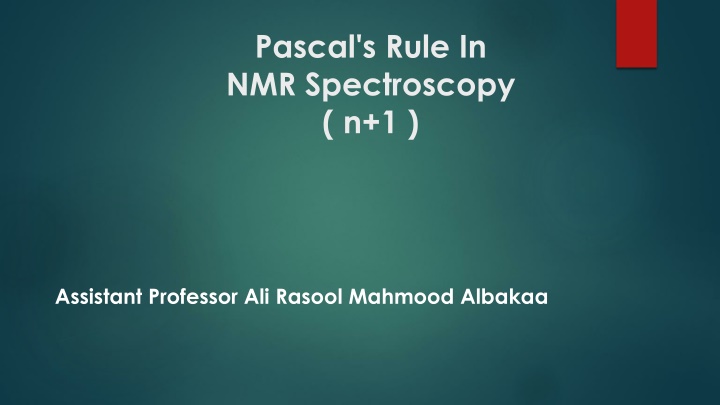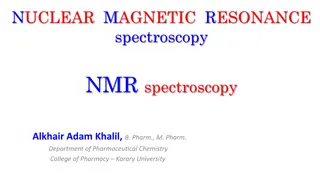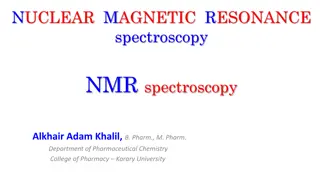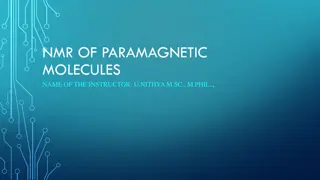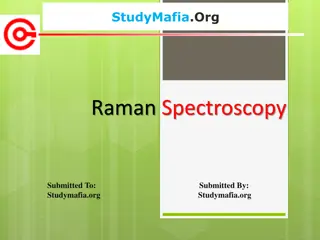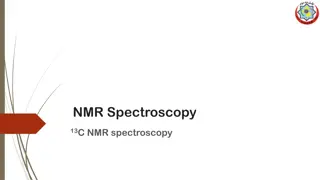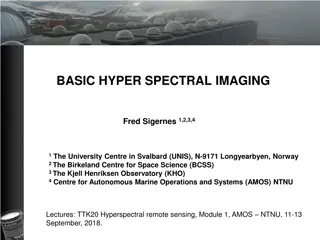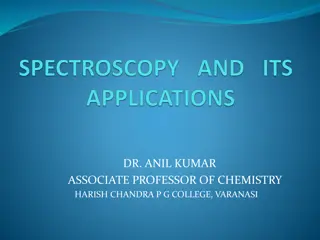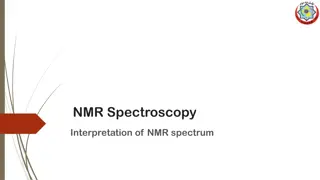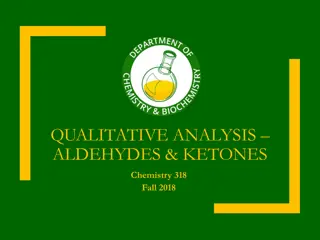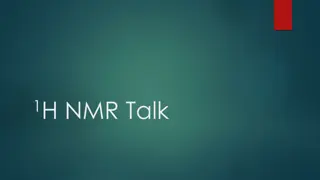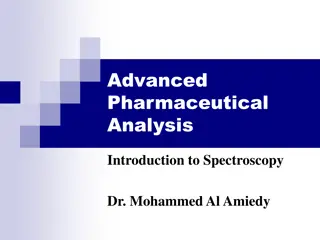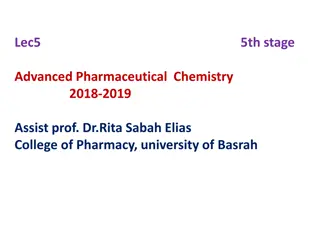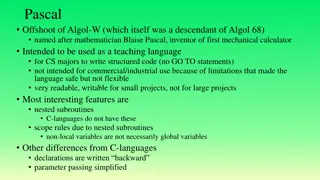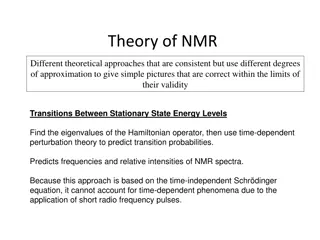Pascal's Rule in NMR Spectroscopy ( n+1 )
Pascal's Rule in NMR spectroscopy, also known as the (N+1) rule, is an empirical rule used to predict the multiplicity and splitting pattern of peaks in 1H and 13C NMR spectra. It states that if a nucleus is coupled to N number of equivalent nuclei, the multiplicity of the peak is N+1. The rule helps in analyzing signal splitting caused by geminal and vicinal hydrogens. Coupling occurs between non-equivalent protons, leading to singlets, doublets, or triplets in the NMR spectrum based on the number of equivalent neighboring nuclei.
Download Presentation

Please find below an Image/Link to download the presentation.
The content on the website is provided AS IS for your information and personal use only. It may not be sold, licensed, or shared on other websites without obtaining consent from the author.If you encounter any issues during the download, it is possible that the publisher has removed the file from their server.
You are allowed to download the files provided on this website for personal or commercial use, subject to the condition that they are used lawfully. All files are the property of their respective owners.
The content on the website is provided AS IS for your information and personal use only. It may not be sold, licensed, or shared on other websites without obtaining consent from the author.
E N D
Presentation Transcript
Pascal's Rule In NMR Spectroscopy ( n+1 ) Assistant Professor Ali Rasool Mahmood Albakaa
The (N+1) Rule, An Empirical Rule Used To Predict The Multiplicity And, In Conjunction With Pascal s Triangle, Splitting Pattern Of Peaks In1H And13C NMR Spectra, States That If A Given Nucleus Is Coupled To N Number Of Nuclei That Are Equivalent. The Multiplicity Of The Peak = N+1, N = Hydrogen Atoms Number In Adjacent Carbon. The Splitting Is Caused By The Hydrogens On The Same (Geminal Hydrogens) Or On The Neighboring Carbons (Vicinal Hydrogens). Only Non-equivalent Protons Split The Signal Of The Given Proton(s). Eg. The three hydrogen nuclei in 1, Ha, Hb, and Hc, are equivalent. Thus, 1H NMR spectrum of 1 Ha s only one peak. Ha, Hb, and Hc, are coupled to no hydrogen nuclei Thus, for Ha, Hb, and Hc , n=0; (n+1) = (0+1) = 1. The multiplicity of the peak of Ha, Hb, and Hc is one, The peak Ha s one line; it is a singlet.
There are two sets of equivalent hydrogen nuclei in 2: Set 1: Ha Set 2: Hb, Hc Thus, the 1H NMR spectrum of 2 Ha s two peaks, one due to Ha and the other to Hb, Hc and . The peak of Ha : There are two vicinal hydrogens to Ha : Hb and Hc . Hb and Hc are equivalent to each other but not to Ha . Thus, for Ha , n=2; (n+1) = (2+1) = 3. The multiplicity of the peak of Ha is three. The peak Ha s three lines; from the Pascal s triangle, it is a triplet. The peak of Hb and Hc : There is only one vicinal hydrogen to Hb and Hc : Ha . Ha is not equivalent to Hb and Hc . Thus, for Hb and Hc , n=1; (n+1) = (1+1) = 2. The multiplicity of the peak of Hb and Hc is two. The peak Has two lines, from the Pascal s triangle, it is a doublet. To determine the multiplicity of a peak of a nucleus coupled to more than one set of equivalent nuclei, apply the (n+1) Rule independently to each other.
When two protons split each others NMR signals, they are said to be coupled. However, not all neighboring protons are coupled. Signal splitting occurs only between nonequivalent protons. It is not observed for homotopic and enantiotopic protons since they are chemically equivalent. For example, starting with simple methane and ethane, both have equivalent protons which do not split each other, and the signal appears a singlet. 1,2-dichloroethane is also a molecule where the hydrogens are equivalent and therefore there is only one singlet.
However, if we replace one of the Cl atoms with a bromine, the hydrogens on the two carbons are not equivalent anymore and they split each other s signal into triplets:
Having one or two atoms disrupts symmetry making protons adjacent carbons nonequivalent: chlorine also the the on It is also possible to have a signal splitting proton on the same carbon if these are diastereotopic: by a protons
For example, how do we distinguish between the two methyl groups in the following molecule? They are both next to electron-withdrawing groups with comparable power and they will both have the same integration. This is where the spin splitting gets into play as, based on it, one of the methyl groups is expected to be a triplet and the other a doublet (n+1 rule).
Eg.1 The following compound gave two proton signals CH3CH2Cl Sol. CH3CH2Cl a b a) n+1= 2+1= 3 => Triplet 3H b) n+1= 3+1=4 => Quartet 2H Eg.2 The following compound gave three proton signals CH3CH2OH Sol. CH3CH2OH a b c a) n+1= 2+1= 3 => Triplet 3H b) n+1= 3+1=4 => Quartet 2H c) n+1= 0+1=1 => Singlet 1H
Eg.3 The following compound gave three proton signals (CH3)2CHCH2Cl Sol. (CH3)2CHCH2Cl a b c a) n+1= 1+1= 2 => Doublet 6H b) n+1= 8+1=9 => Multi 1H c) n+1= 1+1= 2 => Doublet 2H Eg.4 The following compound gave tow proton signals (CH3)3CCH2Cl Sol. (CH3)3C CH2Cl a b a) n+1= 0+1= 1 => Singlet 9H b) n+1= 0+1=1 => Singlet 2H
Eg.5 The following compound gave three proton signals CH3CO CH2CH3 Sol. CH3CO CH2CH3 a b c a) n+1= 0+1= 1 => Singlet 3H b) n+1= 3+1=4 => Quartet 2H c) n+1= 2+1= 3 => Triplet 2H Eg.6 The following compound gave tow proton signals C9H12 Sol. From formula the compound aromatic C6H3 (CH3)3 a b a) n+1= 0+1= 1 => Singlet 3H b) n+1= 0+1= 1 => Singlet 9H S:3H:6.7ppm S: 9H:2.1ppm CH3 -
The simplest signal consists of one line and is called a singlet, followed by the doublet, triplet, etc. A signal with more than seven lines is referred to as a multiplet.
Eg.7 What the structure formula of following compound C11H16 gave S:9H:1.3ppm S:3H: 2.3ppm Multi:4H: 7.33ppm Sol. Through 7.33 ppm and 4H , this compound aromatic, and two substituted positions. S:3H It denotes an methyl group bonded to a carbon atom that is not bonded to a hydrogen atom. CH3 S:9H It denotes three methyl group bonded to a carbon atom that is not bonded to a hydrogen atom . C (CH3) 3 (CH3) 3 C- -CH3
Eg.8 What the structure formula of following compound C8H10 gave Q:2H:2.04ppm T:3H: 2.9ppm S:5H: 7.17ppm Sol. Through 7.17 ppm and 5H , this compound aromatic, and one substituted position. Q:2H It denotes an CH2 group bonded to CH3 , Quartet (--CH2 CH3) T:3H It denotes methyl group bonded to CH2 that Triplet. --CH2 CH3
Eg.9 : What the structure formula of following compound C3H7NO2 gave T:3H: 1.1ppm M:2H: 2.10ppm T:2H:2.5ppm Sol. Through 1.1 ppm and 3H , this compound continuing CH3 bonded with CH2 group. M:2H It denotes an CH2 group bonded to CH3 , and --CH2 ,Multi (-- CH2 --CH2 CH3) T:2H It denotes CH2 group bonded to CH2 that Triplet. CH3- CH2 --CH2 NO2 Eg.10: What the structure formula of following compound C3H7NO2 gave D:6H: 1.7ppm M:1H: 2.1ppm Sol. Through M:2.1 ppm and 1H , this compound continuing CH- bonded with tow carbon atoms Multi hydrogen. D:6H It denotes an CH group bonded to tow CH3 group = 6H (CH3)2 --CH NO2
Eg. 7: What the structure formula of following compound C6H14O gave S:9H: 1.2ppm T:2H: 2.1ppm T:2H: 3.1ppm S:1H: 5ppm Sol. The compound not aromatic, because there is no S in 6-8 ppm Through S:1.2 ppm and 9H , this compound continuing three group of CH3 bonded with carbon atom, Singlet hydrogen. --C (CH3)3 Through T:2.1 ppm and 2H , this compound continuing group of CH2 -- bonded with CH2 -- , Triplet hydrogen. --C H2--CH2 Through T:3.1 ppm and 2H , this compound continuing group of CH2- bonded with CH2 - , Triplet hydrogen. -C H2-CH2- After calculating the two groups above, an oxygen atom and a hydrogen atom remain, --OH , alcohol . (CH3)3C--C H2-CH2- OH
Eg. 8: What the structure formula of following compound C6H14O gave S:9H: 1.2ppm D:3H: 2.1ppm Q:1H: 3.1ppm S:1H: 5.1ppm Sol. The compound not aromatic, because there is no S in 6-8 ppm Through S:1.2 ppm and 9H , this compound continuing three group of CH3 bonded with carbon atom, Singlet hydrogen. --C (CH3)3 Through D:2.1 ppm and 3H , this compound continuing group of CH3 bonded with CH-- , Doublet hydrogen. --C H CH3 Through Q:3.1 ppm and 1H , this compound continuing group of CH- bonded with CH3 , Quartet hydrogen. -CH-CH3 After calculating the two groups above, an oxygen atom and a hydrogen atom remain, Through 5.1ppm -OH , alcohol . (CH3)3C-CH(OH)-CH3
Eg. 9: What the structure formula of following compound C10H12O2 gave S:6H: 1.3ppm S:5H: 7.5ppm S:1H: 10.6ppm Sol. The compound aromatic, because there is S in 7.5 ppm, 5H one substituted position. Through S:1.3 ppm and 6H, this compound continuing tow group of CH3 bonded with carbon atom, Singlet hydrogen. --C (CH3)2 Through S:10.6 ppm and 1H, this compound continuing carboxylic group COOH. --C(CH3)2--COOH
Eg. 8: What the structure formula of following compound C9H10O gave S:3H: 1.2ppm S:2H: 2.1ppm S:4H: 7.5ppm S:1H: 9ppm Sol. The compound aromatic, because there is S in 7.5 ppm, 4H tow substituted position. Through S:1.2 ppm and 3H, this compound continuing one group of CH3 bonded with carbon atom in aromatic ring, ph-CH3 Through S:2.1 ppm and 2H, this compound continuing one group of CH2- bonded with carbon atom in aromatic ring, ph-CH2- Through S:9 ppm and 1H, this compound continuing aldehyde group of CHO CH3- -CH2-CHO
Eg.11: What the structure formula of following compound C11H16 gave S:5H: 7.2ppm S:2H: 2.5ppm S:9H:0.9 ppm Eg.12: What the structure formula of following compound C7H8 gave S:3H: 2.3ppm S:5H: 7.2ppm Eg.13: What the structure formula of following compound C8H8Br2 gave D:2H: 4.1ppm T:1H: 5.2ppm S:5H:7.2ppm Eg.14: What the structure formula of following compound C2H5Br gave T:3H: 1.7ppm Q:2H: 3.4ppm Eg.15: What the structure formula of following compound C2H4Br2 gave D:3H: 2.4ppm Q:1H: 5.8ppm Eg.16: What the structure formula of following compound C8H10 gave S:4H: 7.6ppm S:6H: 2.2ppm
Practice 1. Indicate the number of signals and the multiplicity of each signal in the 1H NMR spectrum of each of the following compounds: Hint: Draw out the hydrogens on each carbon to follow the n+1 rule.
Thank you for listening Thank you for listening
